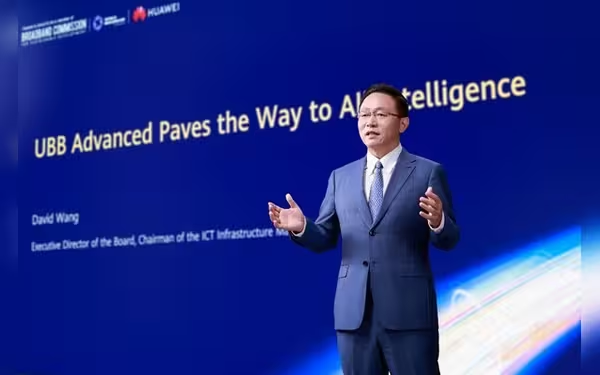Thursday, November 7, 2024 12:38 PM
Huawei's David Wang Highlights AI and UBB Integration at UBBF 2024
- AI drives global economic growth and transformation.
- Huawei's All Intelligence Strategy connects devices effectively.
- UBB 5.5G technology enhances AI application demands.
 Image Credits: en_prnasisa
Image Credits: en_prnasisaDavid Wang of Huawei emphasizes AI and UBB integration at UBBF 2024, highlighting its role in economic growth and digital transformation.
In the rapidly evolving landscape of technology, the integration of artificial intelligence (AI) with ultra-broadband (UBB) networks is becoming increasingly vital. At the recent 10th Ultra-Broadband Forum (UBBF 2024) held in Istanbul, David Wang, Huawei's Executive Director of the Board, emphasized the importance of this synergy in his keynote speech titled "UBB Advanced Paves the Way to All Intelligence." Wang's insights shed light on how AI is not just a trend but a significant driver of global economic growth, transforming various sectors and enhancing user experiences.
Wang highlighted that the Fourth Industrial Revolution is being propelled by AI, which is now widely used in personal applications, enterprise efficiency, and smart home technologies. This widespread adoption is not only changing markets but also necessitating upgrades in communication networks to improve capacity, reduce latency, and enhance overall architecture. He stated, "Huawei has continued innovating by focusing on two areas: UBB for AI and AI for UBB." This dual approach aims to leverage ultra-large bandwidth and low latency to foster better AI development and network experiences.
Huawei's All Intelligence Strategy, introduced last year, aims to connect all devices, model applications, and compute decisions effectively. The company is committed to providing robust digital and intelligent infrastructure that supports various industries in their quest for intelligent transformation. By utilizing its Pangu Models, Huawei is creating advanced, industry-specific models that cater to a wide range of applications.
In the telecommunications sector, Huawei's AI solutions are crucial for enhancing transmission power, which is essential for other industries to transition to digital and intelligent operations. Wang outlined two key development paths for UBB networks: "UBB for AI" and "AI for UBB." The introduction of UBB 5.5G technology is a significant step forward, incorporating innovations across multiple network layers to meet AI demands.
For data center networks, Huawei's Dragonfly+ Topology architecture and new DC-OXC technologies are designed to build large-scale computing centers efficiently. Additionally, innovative technologies such as 800G IP + Optical networking are being employed to optimize computing power across data centers. These advancements are crucial for ensuring that networks can handle the increasing demands of AI applications.
Moreover, Huawei's OXC Mesh networking significantly reduces latency, while Wi-Fi 7 and 50G PON technologies provide the necessary 10 gigabit access for widespread AI adoption. The company's FTTR technology is already being utilized to create "intelligent hubs" in homes, enhancing the user experience with intelligent applications.
Wang also discussed the importance of resilience in networks, highlighting Huawei's Xinghe security gateway and hybrid ASON technologies that ensure robust connections for AI applications. These innovations are set to improve bandwidth, latency, and overall network capabilities, allowing carriers to stand out in the intelligent era.
As UBB networks grow larger and more complex, the need for improved operational efficiency and network autonomy becomes paramount. Huawei is exploring the integration of AI directly into networks, creating an AI-enabled O&M architecture that utilizes digital twins and Telecom Foundation Models. This architecture facilitates the development of intelligent "copilots" and scenario-specific "agents" that automate operations and maintenance, paving the way for advanced autonomous networks.
Wang concluded his speech by urging the UBB industry to embrace the intelligent era through innovation in UBB 5.5G technologies. He emphasized the need for industry-wide collaboration to incubate new intelligent services, stating that partnerships and business opportunities in AI applications will be key to driving transformation and growth.
In summary, the intersection of AI and UBB networks is not just a technological advancement; it represents a fundamental shift in how industries operate and interact with consumers. As companies like Huawei lead the charge in this transformation, the potential for enhanced efficiency, improved user experiences, and new business opportunities is immense. Embracing these innovations will be crucial for businesses aiming to thrive in an increasingly intelligent world.













